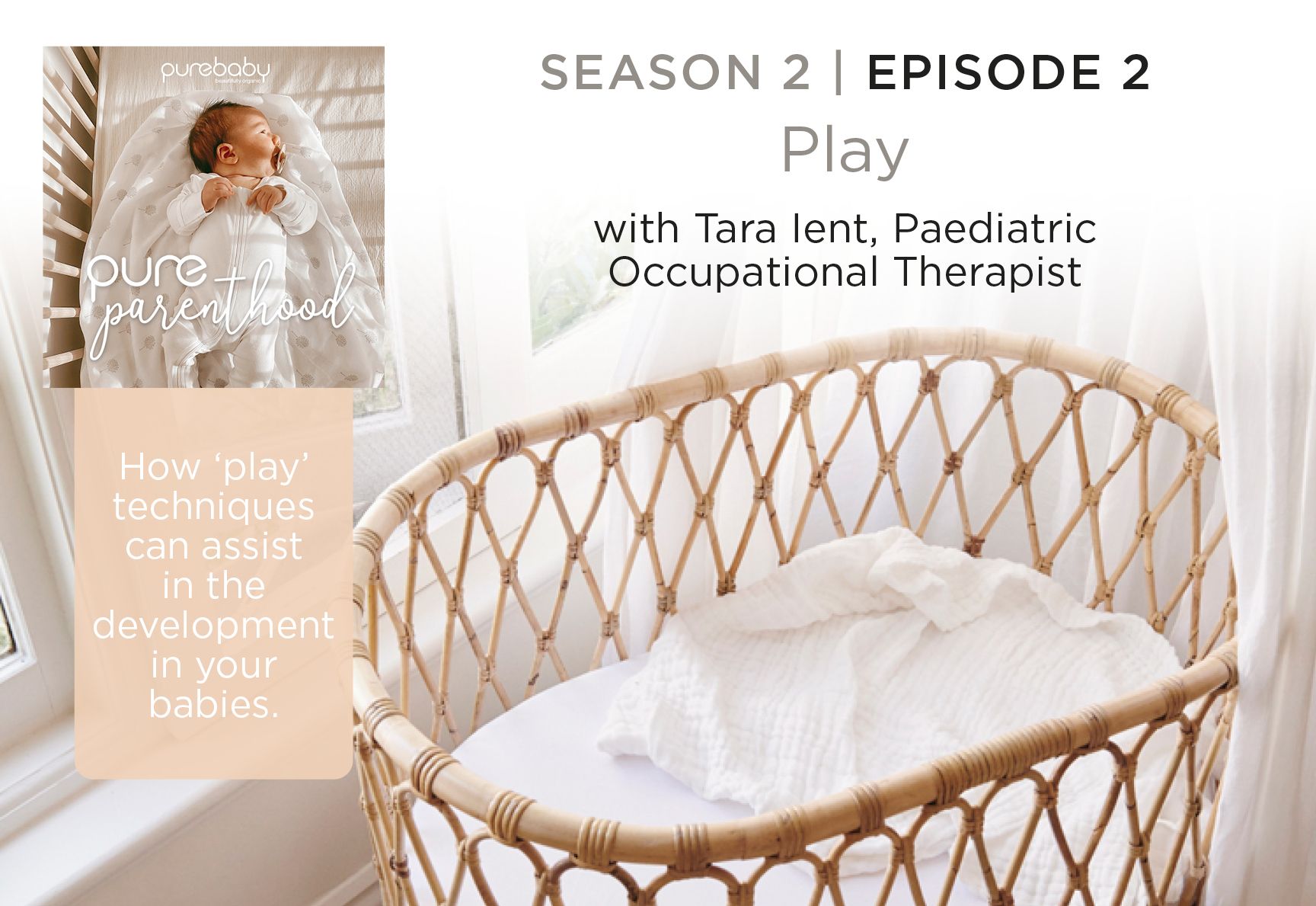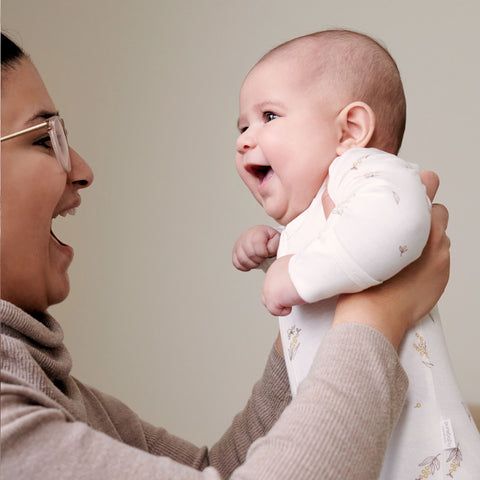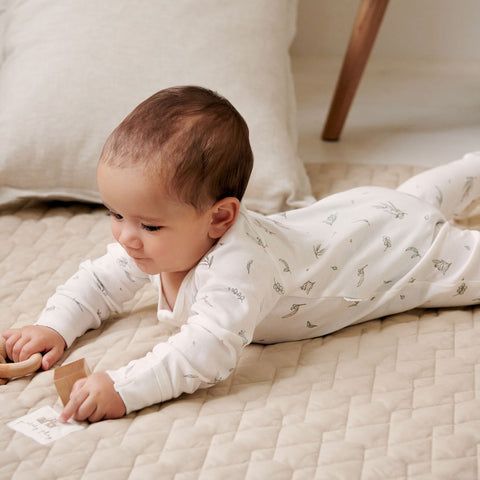
How to Use & Clean Reusable Cloth Nappies
6 min read | 25 February 2021
13 min read | 08 March 2021

Baby play is just a fancy term for purposefully interacting with your baby and who doesn’t love playing with cute little chubby babies? Play is essential for your baby’s overall development, learning and wellbeing. Through play, your baby learns about the world around them as they explore and discover how things work.
A good time to start playing with your baby is from the start! Of course in those first 3 months or so, most of your “play” interactions will be short and sweet as they will spend their time mostly feeding and sleeping and can get overstimulated easily. However, don’t underestimate the importance of those little windows of awake time and enjoy soaking in each other’s company!
Playing and interacting with a baby looks a little different to playing with toddlers or older children, but that doesn’t mean it needs anything fancy or special and doesn’t require a degree! Putting it simply, baby play involves giving them time, attention and new experiences to aid in development.
The most ideal window of time to engage in play with your child is when they are happy and calm. This is usually after they have had a good feed and appear settled and may enjoy some awake playtime before their next sleep.
To engage in baby play, technically all you need is yourself and your baby! You know that you're doing it right if you are having fun and your child is reacting to you. Some of the reactions you might see are:
Giving you eye contact
Smiling
Cooing
Attempting to copy your sounds or movements

Baby play should be kept simple, however as parents we are always looking to have some ideas at hand to help us know we are on the right track for helping our child’s development, not to mention there is a whole toy market out there bewildering us all!
The best toy for your baby is you, however there is a wealth of resources available out there for parents to learn more about interacting with their baby to foster development such as the Raising Children's Network.
The best advice I can give to parents is to always follow your child’s lead. This means if you see them interested in something or liking something you did – use that to keep them engaged and then slowly bring something new or different into the play and see how they respond. This might be as simple as blowing a raspberry and then adding a noise in.
I can’t tell you how many times I’ve made or set something up that I think is so good, only for my son to not care for it one single bit or lose interest very quickly – and that’s because it wasn’t following his current interests but rather what I thought looked fun! It’s definitely worth spending some time noticing what your child gravitates towards from about 4 months of age, and using those things to engage them!
There are literally endless things to do with children because the world is a whole new concept to them, everything is exciting! Below are some of my favourite things to do with little ones during their different ages and stages of development. Keep in mind that every child is different, has different interests and develops at different rates.
Babies between 0-3 months of age can’t see very far and love contrasting patterns (think black and white), but they also get overstimulated very quickly. 5-10 minutes is more than enough “play time” between sleeps. Here are some of the ways you can play with your newborn.
Get your baby looking at your face while you smile
Blow raspberries or make different faces
Make gentle noises and copy any sounds they make
Gentle movement experiences such as swaying, bouncing together
Touching their face, arms, legs, tummy etc with both light touch and firmer baby massage
Singing songs
Doing tummy time together
Babies between 4-6 months of age are drawn to colours, patterns and shapes of different objects and toys. They love to touch everything and may start mouthing objects too so this is also the time to start baby proofing your home to make it safe for exploring! This is when they get more active and will want to use their arms and legs more, so look to engage in lots of active play opportunities such as:
Floor play time
Playing with things that rattle when they move them
Space to practice rolling
Listening to music
Talking, reading, singing and moving to nursery rhymes
Playing peekaboo
Safe sensory play
Exploration of textures and outdoor time in nature!
Babies of this age may move quickly between activities, showing an attention span of only 2-3 minutes before looking for the next thing to do. It is a good time to practice some independent play at this stage too! Again, lots of active play opportunities such as:
Using motivating items to encourage crawling, pulling to stand and cruising
Practice on a washing basket, coffee table or couch by placing toys to collect.
Cause and effect toys
Books for them to look at
Reading, talking and singing together
At this age often the most motivating toys for them are everyday household objects such as the recycling, the tupperware drawer and remotes!
Plenty of sensory play opportunities!

Sensory play might sound like this magical concept that requires elaborate setups and resources but fear not, sensory play is literally anything that stimulates your child’s senses.
Anything that makes them use their sight, smell, hearing, touch, taste or move their bodies can be called a sensory activity! The best bit is you already have a wealth of resources in your kitchen pantry and cupboards for sensory play.
Not only is sensory play super enticing for those inquisitive little beings, engaging in sensory play helps build new nerve connections in the brain, which leads to children developing more complex learning pathways for all of life’s skills to come. There is so much evidence that states children learn best by doing; touching, feeling, experiencing, this is the magic of sensory play. Engaging children in sensory play activities works on;
Language development
Fine and gross motor development
Problem solving skills
Social interaction skills
Cognitive development
Hanging different textures, things that make noise and different colours from their baby play gym or stuck to the wall/furniture
Scrunching up baking or wrapping paper
Playing in front of a mirror
Setting up a small basket of toys to explore e.g.
soft toys, bumpy balls,
teething toysWater play. Water fixes everything. You can add a drop of food colouring, beach/bath toys or utensils/cups also!
Time outdoors on different surfaces e.g. grass, sand and looking at trees blowing in the wind
Dried rice and pasta play. Think about the sound and tactile sensations they provide. You can also colour these with food dye to make it a bit fancier!
Pots, pans or tupperware for drum play
Dancing time to music, rolling, bouncing, spinning
Cooked spaghetti, jelly or other safe foods in a tub to explor
Obstacle courses or build cubbies with your lounge cushions
Edible paint made from baby cereal and food colouring for finger painting fun
Hidden objects to search and find in a sensory base of your choice eg. rice, pasta, sand, water
Ice cube play to experience different temperatures. Try freezing their toys in ice for them to melt down!

A Paediatric Occupational Therapist aids children in building skills and overall development in an array of different areas, such as playing, eating, sleeping, interacting, dressing, behaviour, learning, sensory processing and emotional regulation. If children are experiencing difficulties in their development, which is impacting on their ability to participate at home, at childcare, at school or in the community, then an Occupational Therapist can help them to build their skills so they can succeed in those environments.
Don’t take overthink it, be silly, be loving, have fun and enjoy the moment.
Follow your baby’s lead. Use their interests to work on developmental skills.
Play strengthens your relationship with your child and doesn’t need to be fancy or require expensive toys. Keep it simple!
Don’t be afraid of the mess that comes with sensory play. We want our kids to tolerate being messy and enjoy all the types of sensations life is going to throw at them.
This article was written by Tara Ient, in conjunction with the Pure Parenthood Podcast. Tara is a Paediatric Occupational Therapist. Learn more about play by visiting @lets_play_charlie on Instagram.
www.raisingchildrennetwork.net.au www.playgroupnsw.org.au www.rednose.org.au @lets_play_charlie @nicole_kidsphysio @play_at_home_mummy
Sign up to Pure Love Rewards and get $10 off your first online order, earn points every time you shop and more!